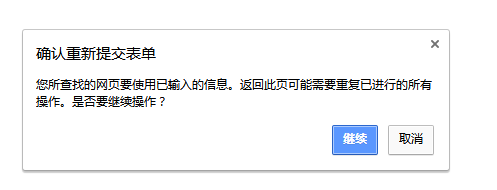一,回顾
(1)默认action,404问题;<default-action-ref name="action 名称"/>
(2)模块化,package,struts.xml
(3)异常配置,全局异常的作用返回,用一个package,global-result,global-exceptioni-mappings
(4)结果类型,dispatcher,redirect,chain,redirectAction;action节点的result节点的type属性
(5)访问servlet容器对象;ActionContext,ServletActionContext,ServletRequestAware,ServletContextAware
二,DRY原则
Don't Repeat Yourself 不要写重复的代码
应该将功能相似的代码封装为方法,在需要的地方直接调用方法即可,若需要修改逻辑代码,我们也只需要修改方法内部的实现就可以,大大减少了维护量,提供工作效率
三,表单重复提交
(1)Demo1Action
@Getter @Setter public class Demo1Action extends ActionSupport { private String uname; private String pname; public String login(){ System.out.println("姓名:"+uname+",密码:"+pname); //传到数据库中,进行匹配 return SUCCESS; } }
(2)struts.xml
<action name="demo1Action" class="com.yujun.maven.action.Demo1Action">
<result>/demo1.jsp</result>
</action>
(3)demo1.jsp

(4)运行

当表单提交后,使用内部方式调用到页面,再次手动刷新页面时就会出现上图所示的重复提交问题;此时点击继续按钮,会发现我们后台的方法代码被重复执行一次;
解决方案:
(1)使用重定向来跳转页面
(2)使用token拦截器
四,拦截器
拦截器是动态拦截action调用的对象
提供一种机制,可以使开发者定义在一个action执行的前后执行的代码,也可以在一个action执行前阻止其执行;通过此机制可以将多个action中重复代码提取到拦截器中定义
提高代码重用性
大部分时候,拦截器底层实现都是通过"代理"方式
struts2拦截器实现相对简单,当请求达到struts2的核心过滤器,struts2查找配置,并根据配置实例化相应的拦截器,然后串成一个列表(list),最后一个一个的调用列表中的拦截器;
struts2中拦截器是可插拔的(通过配置让其可有可无),拦截器是AOP编程(面向切面)一种实现方式
struts2连接器栈,就是将拦截器按一定的顺序链接成一条链,在访问被拦截的方法或字段时,struts2拦截器链中的拦截器就会按照自己的顺序依次被调用

注意的是,拦截器执行顺序,来的是和去的时候正好相反
五,表单重复提交解决
使用token拦截器的解决方式
(1)表单页面
<!-- 防止表单重复提交 -->
<s:token></s:token>
(2)struts.xml
<action name="demo1Action" class="com.yujun.maven.action.Demo1Action">
<result>/demo1.jsp</result>
<!-- 当表单重提交时的返回值 -->
<result name="invalid.token">/demo1_fail.jsp</result>
<!-- 默认拦截器栈 -->
<interceptor-ref name="defaultStack"></interceptor-ref>
<!-- 拦截器引用,token是struts2提供的,防止表单的重复提交 -->
<interceptor-ref name="token"></interceptor-ref>
</action>
(3)demo1_fail.jsp
<h3>
你已经提交过一次表单,请勿重复提交!!!
</h3>
六,自定义拦截器(重点)
通常有三种实现方式
(1) 实现Interceptor接口
(2)继承Abstractinterceptor类
(3)继承MethodFilterInterceptor
1、Interceptor接口
(1)MyInterceptor1类
public class MyInterceptor1 implements Interceptor { //销毁 @Override public void destroy() { System.out.println("MyInterceptor1.destroy..."); } //初始化 @Override public void init() { System.out.println("MyInterceptor1.init..."); } //核心 @Override public String intercept(ActionInvocation invocation) throws Exception { System.out.println("MyInterceptor1.intercept...start"); //把请求往下传递 String result = invocation.invoke(); System.out.println("MyInterceptor1.intercept...end"); return result; } }
(2)struts.xml
在package节点中声名
<!-- 声明拦截器 -->
<interceptors>
<!-- name:拦截器名称,唯一,class:类全名 -->
<interceptor name="my1" class="com.yujun.maven.interceptor.MyInterceptor1"></interceptor>
</interceptors>
在action节点中使用
<action name="demo2Action" class="com.yujun.maven.action.Demo2Action">
<result>/demo2.jsp</result>
<interceptor-ref name="defaultStack"></interceptor-ref>
<interceptor-ref name="my1"></interceptor-ref>
</action>
注意,这里action中也是需要引用“defaultStack”默认拦截器栈的,因为action一旦配置拦截器,默认的拦截器栈就不会生效,这里需要我们手动配置上去
(3)demo2.jsp
<h3>
this is demo2.jsp
</h3>
(4)运行
http://127.0.0.1:8080/struts2-chapter2/demo2Action!m1.action

2、继承AbstractInterceptor类
(1)MyInterceptor2类
public class MyInterceptor2 extends AbstractInterceptor { @Override public String intercept(ActionInvocation invocation) throws Exception { System.out.println("MyInterceptor2.intercept...start"); String result = invocation.invoke(); //把请求往下传递 System.out.println("MyInterceptor2.intercept...end-"+result); return result; } }
(2)struts.xml
<!-- 声明拦截器 -->
<interceptors>
<!-- name:拦截器名称,唯一,class:类全名 -->
<interceptor name="my1" class="com.yujun.maven.interceptor.MyInterceptor1"></interceptor>
<interceptor name="my2" class="com.yujun.maven.interceptor.MyInterceptor2"></interceptor>
</interceptors>
使用
<action name="demo2Action" class="com.yujun.maven.action.Demo2Action">
<result>/demo2.jsp</result>
<interceptor-ref name="defaultStack"></interceptor-ref>
<interceptor-ref name="my1"></interceptor-ref>
<interceptor-ref name="my2"></interceptor-ref>
</action>
(3)运行
http://127.0.0.1:8080/struts2-chapter2/demo2Action!m1.action

3、继承MethodFilterInterceptor类
(1)MyInterceptor3
public class MyInterceptor3 extends MethodFilterInterceptor { @Override protected String doIntercept(ActionInvocation invocation) throws Exception { System.out.println("MyInterceptor3.doIntercept...start"); String result = invocation.invoke(); //把请求往下传递 System.out.println("MyInterceptor3.doIntercept...end-"+result); return result; } }
(2)struts.xml
<!-- 声明拦截器 -->
<interceptors>
<!-- name:拦截器名称,唯一,class:类全名 -->
<interceptor name="my1" class="com.yujun.maven.interceptor.MyInterceptor1"></interceptor>
<interceptor name="my2" class="com.yujun.maven.interceptor.MyInterceptor2"></interceptor>
<interceptor name="my3" class="com.yujun.maven.interceptor.MyInterceptor3"></interceptor>
</interceptors>
使用
<action name="demo2Action" class="com.yujun.maven.action.Demo2Action">
<result>/demo2.jsp</result>
<interceptor-ref name="defaultStack"></interceptor-ref>
<interceptor-ref name="my1"></interceptor-ref>
<interceptor-ref name="my2"></interceptor-ref>
<interceptor-ref name="my3">
<!-- 排除方法(不拦截) -->
<param name="excludeMethods">m2,m3</param>
<!-- 包含方法(拦截) -->
<param name="includeMethods">m1</param>
</interceptor-ref>
</action>
4、注意
前两种方式,会拦截action中所有方法,最后一种方式,如果不配置属性,默认也是拦截所有action中方法
七、拦截器栈(链)
将一个个单独的拦截器放入列表中组成一个链
<!-- 声明拦截器 -->
<interceptors>
<!-- name:拦截器名称,唯一,class:类全名 -->
<interceptor name="my1" class="com.yujun.maven.interceptor.MyInterceptor1"></interceptor>
<interceptor name="my2" class="com.yujun.maven.interceptor.MyInterceptor2"></interceptor>
<interceptor name="my3" class="com.yujun.maven.interceptor.MyInterceptor3"></interceptor>
<!-- 把拦截器封装为拦截器栈 -->
<interceptor-stack name="myStack">
<!-- 拦截器引用 -->
<interceptor-ref name="my1"></interceptor-ref>
<interceptor-ref name="my2"></interceptor-ref>
<interceptor-ref name="my3"></interceptor-ref>
</interceptor-stack>
</interceptors>
使用
<action name="demo2Action" class="com.yujun.maven.action.Demo2Action">
<result>/demo2.jsp</result>
<interceptor-ref name="defaultStack"></interceptor-ref>
<interceptor-ref name="myStack"></interceptor-ref>
作业:通过struts2拦截器,拦截器未登录
八、拦截器和过滤器的区别
(1)拦截器是基于java反射机制,而过滤器是基于函数回调
(2)过滤器依赖于servlet容器,而拦截器不依赖于servlet容器
(3)拦截器只会action起作用,而过滤器对所有请求生效(静态资源、action)
(4)拦截器可以访问action上下文、值栈的对象,而过滤器不行
(5)在action的声明周期中,拦截器可以多次调用,而过滤器只会在容器初始化时只需一次
探索:
请自行新建一个过滤器(filter),在web.xml中进行过滤器注册,在过滤器的核心方法中打印输出语句,最后请求action的目标方法(m1/m2/m3....),到底是过滤器先执行还是拦截器先执行,然后重复访问action中目标方法,再看看控制台输出情况是怎么样的?